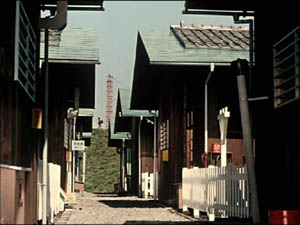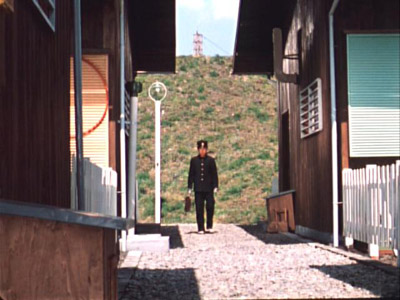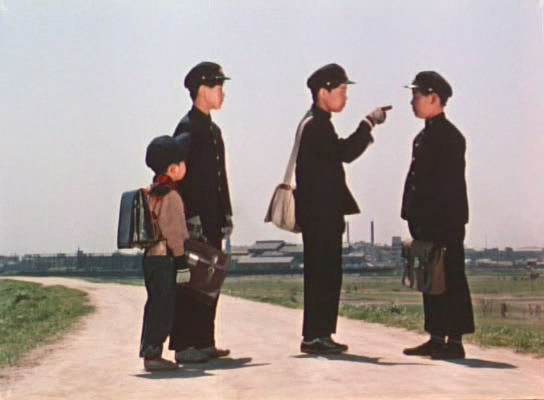From the Monthly Film Bulletin, no. 502, November 1975. — J.R.
OHAYO (GOOD MORNING)
Japan, 1959
Director: Yasujiro Ozu
Cert — U. dist — Cinegate. p.c — Shochiku/Ofuna. p — Shizuo Yamanouchi. sc — Yasujiro Ozu, Kogo Noda. ph — Yushun Atsuta. col — Agfacolor. ed —Yoshiyasu Hamamura. a.d —Tatsuo Hamada. m — Toshiro Mayuzumi. l.p — Chishu Ryu (Keitaro Hayashi), Kuniko Miyake (Tamiko Hayashi), Yoshiko Kuga (Setsuko Arita, Tamiko’s Sister), Koji Shidara (Minoru Hayashi, Older Son), Masahiko Shimazu (Isamu Hayashi, Younger Son), Keiji Sada (Heichiro Fukui, English Teacher), Haruo Tanaka (Pencil Salesman), Haruko Sugimura (Mrs. Haraguchi), Miyaguchi (Mr. Haraguchi), Eiko Miyoshi (Mrs. Haraguchi’s Mother), Eijiro Tono (Tomizawa), Teruko Nagoako (Tomizawa’s wife), Sadako Sawamura (Mrs. Okubu), Kyoko Izum and Hasabe (Couple with TV Set), Toyo Takahashi. 8,460 ft. 94 mins. Subtitles.
In a Tokyo suburb, Minoru and Isamu Hayashi — aged thirteen and seven, respectively — play a game of pushing one another’s forehead and farting with their friends Zen Okubu and Kozo Haraguchi. The latter winds up defecating instead and has to return home for a change of undershorts. Meanwhile, there is some consternation about the disappearance of the local women’s club dues, and the fact that Mrs. Haraguchi, the treasurer, has recently bought a washing machine is the cause of some suspicion, until the latter discovers that her mother has absentmindedly put the dues aside. Minoru and Isamu are chastised by their mother Tamiko for watching television in a neighbor’s house instead of attending their English lesson; their English teacher, Heichiro, currently jobless, is given translation work by their aunt, Setsuko, while the equally jobless Tomizawa drunkenly complains to their father Keitaro about the difficulty of being retired by his company. Keitaro comes home to find his sons fretting because of Tamiko’s refusal to buy a television set; he tells them they talk too much and grows angrier when Minoru insists that grown-ups do the same, citing phrases like “Good morning” and “Fine day”; they retaliate by taking a vow of silence. When they fail to greet Mrs. Haraguchi the next day, she assumes this is because Tamiko is sore about the misplaced dues and tells Mrs. Okubu that Tamiko holds grudges; Mrs. Okubu promptly returns a bottle of beer and a bus ticket to Tamiko and warns Tomizawa’s wife. Refusing to speak in school and unable to ask their parents for lunch money, Minoru and Isamu flee from home with rice and tea when their schoolteacher turns up; the couple with the television have meanwhile moved away and Tomizawa has started work as an electrical appliance salesman. Heichiro goes out looking for the boys and finally brings them home, where they find that Keitaro has bought a television from Tomizawa. Greeting Mrs. Haraguchi the next day, they join Zen and Kozo and resume their farting game; Kozo again has to return home. At the train station, Heichiro and Setsuko say “Good morning” to one another and discuss the weather and cloud formations; Kozo is chastised by his mother and his shorts are hung out to dry.
Devoted to both the profound necessity and the sublime silliness of gratuitous social interchange, OHAYO is a rather subtler and grander work than might appear at first. Commonly referred to as a remake of Ozu’s silent masterpiece I WAS BORN, BUT . . . , it is as interesting for its differences as for its similarities. The focus of the earlier film is a family adapting to a new neighborhood by undergoing brutal social initiations: the father humiliates himself before his boss to get ahead while the sons are accepted by their peers only after humiliating a local bully. Shocked by the behavior of their father, who says that he has to demean himself in order to feed them, the sons retaliate by going on a hunger strike. In the lighter climate of OHAYO, twenty-seven years later, the setting is again middle-class Tokyo suburbia, but the central family is firmly settled, and serious problems — whether old age, unemployment, or ostracism — are principally reserved for their neighbors and friends. The sons’ complaint this time is that their parents won’t purchase a television set and that grown-ups talk too much; the form of their rebellion is refusing to speak. Significantly, it is the humiliations in the first film which provide much of the comedy, a subject assuming gravity only when it causes a rift between father and sons. But the more pervasive humor of OHAYO extends to the rebellion itself and all it engenders, as well as the various local intrigues surrounding it. Clearly one of Ozu’s most commercially minded movies — with its stately, innocuous muzak of xylophone and strings recalling Tati backgrounds, a similar tendency to keep repeating gags with only slight variations, and a performance of pure ham (quite rare in an Ozu film) by the delightful Masahiko Shimazu as the younger brother — its intricacy becomes apparent only when one realizes that each detail intimately links up with every other. Rhythmically, this is expressed by the alternation of simply stated (if interlocking) miniplots with complex camera setups, less bound by narrative advancement, depicting the physical layout of the neighborhood itself: the perpendicular passageways between houses and the overhead road on the embankment behind brilliantly suggesting certain structures as well as strictures in a society of interdependent yet insulated busybodies. In a context where banal greetings among neighbors, schoolboy farting contests, and sweet nothings between a couple are treated as structural equivalents, and sliding doors and shot changes become integral facets of the same “architecture” — an interrelating complex of adjacent, autonomous units — the fascination is how even throwaway details become part of the design. A poster for THE DEFIANT ONES, for instance, alludes not only to the recalcitrant sons, but the sense of antagonistic parties chained together by circumstance that often seems to function just below the surface of the everyday pleasantries. A grandmother muttering gripes in between her prayers, a drunken Tomizawa coming home to the wrong house, the young scat-singing couple (at whose home the boys watch television, courting disapproval) being quietly hounded out of the community, a thoughtful Keitaro wondering if television will “produce 100 million idiots” or pondering his future retirement: all these moments are characteristically uninflected, and each goes straight to the heart of the film. Mainly designed to look as casual and as inconsequential as its title, GOOD MORNING gleefully embraces a world that I WAS BORN, BUT . . . can acknowledge only painfully. With a father figure at the center of its constellation —Chishu Ryu, as Keitaro — who is exempt from ridicule, it neither seeks nor finds any comparable reasons for serious doubts or despair. Yet thanks to the precision and consistency of the vision, Ozu can take up all the other grinning denizens of this discreetly closed world and pin their endearing absurdities neatly into place.






